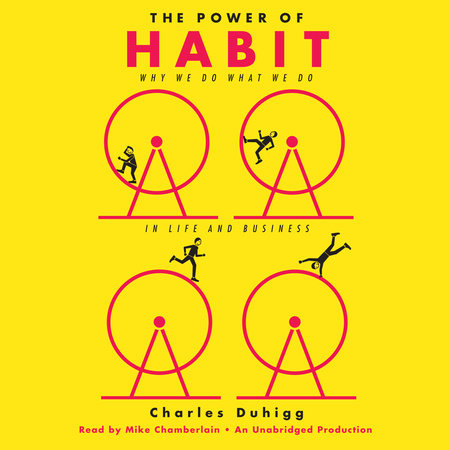 |
The Power of Habit: Why We Do What We Do in Life and Businessby Charles Duhigg, Mike Chamberlain (Narrator) Unabridged Audiobook, 10 hrs, and 53 min. Read: June 8-9, 2020 |

In Part One, Duhigg sketches the science behind habit by looking at a case study of someone who made radical changes to their health and lifestyle by choice, and one who made similar changes as a result of a disease that damaged his brain and removed choice from the equation. It was simply fascinating as he both related the cases and explored the science behind it.
Part Two shifts to the habits of organizations—how some megacorporations changed from within because they intentionally created institutional habits, which then spill over (sometimes intentionally, sometimes not) into the lives of their employees. Alcoholics Anonymous also serves as an example of intentional change here. The section’s last chapter focuses on how companies can study the purchasing and browsing activities of customers to predict and manipulate spending habits. Some of this last chapter is truly disturbing and makes me want to read Qualityland again—and make more people read it.
In Part Three, his focus is on “Societies” and he shows how the Montgomery Bus Boycott illustrates the ideas he’s been describing—and how Rick Warren’s Saddleback Church is an intentional use of the same ideas (quick digression: I have less respect for Warren’s ecclesiology now, although some of what bothered me could be an unbeliever’s description of his actions and theory rather than Warren’s). The last chapter discusses the case of someone with night terrors who commits a crime and a gambling addict’s actions—are either responsible for what happens when their behaviors are mandated by habit rather than a conscious decision? I found this last chapter problematic and a bit simplistic in the way it dealt with the ethical questions. But it’s still very thought-provoking.
As far as the audiobook-ness of this goes, it was okay. Chamberlin did a fine job with the material he was given. Yeah, occasionally, I felt like I was listening to a super-long podcast episode, but I’m not sure that’s a flaw. And if it is, it’s probably due to the text, not a problem on Chamberlin’s part. Like with a lot of Non-Fiction audiobooks, it’s hard to separate the authorial “I” from the voice saying “I,” so I have this cockamamie impression that I’ve gotten to know Duhigg a little bit. Am I the only one who has that problem?
The subtitle is “Why We Do What We Do…” and that’s what this book is about. Somewhere along the line, I’d gotten the idea that there’d be a little more “here’s what to do with this information” to the book. But that was wrong—Duhigg sketches it in an appendix, but it’s just a sketch. Yes (as he says himself), it’s not that difficult to use a lot of what’s covered (particularly in Part One) on your own. I’d have preferred a little more application to go with the theory, but that wasn’t his point, so I shouldn’t quibble.
This is a fascinating book. That’s all I have to say on that front. But I’m not sure what to do with the information. I’m not against learning things to learn them, but this seems to be begging for practical applications—in personal or business life. But I just don’t know how. Maybe that’s because I lack the imagination to apply it, or maybe it’s a shortcoming from the book in not doing a better job in pointing to it. I’m leaning to the latter, but expect it’s the former.

This post contains an affiliate link. If you purchase from it, I will get a small commission at no additional cost to you. As always, opinions are my own.
![]()




Read Irresponsibly, but please Comment Responsibly